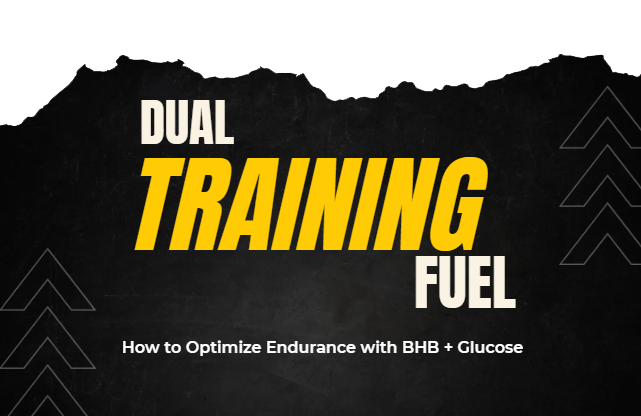How to Optimize Endurance with BHB + Glucose
For athletes and fitness enthusiasts seeking peak endurance performance, the concept of dual-fuel workout strategies—using both BHB (beta-hydroxybutyrate) and glucose—is rapidly gaining traction. This comprehensive guide breaks down how to implement dual-fuel training with goBHB® and glucose, grounded in science and applicable to real-world training.
What Is Dual-Fuel Training?
Dual-fuel training involves leveraging two distinct energy substrates:
- Glucose (Carbohydrate): Provides immediate, high-intensity fuel via glycolysis.
- BHB (Ketone Body): Offers sustained, oxidative fuel with higher ATP yield and lower oxidative stress.
This method mirrors the Dual Fuel Performance Stack approach, optimizing both rapid energy and long-term endurance
by combining the best attributes of carbohydrates and ketones.

Why Combine BHB + Glucose?
Physiologically, the body naturally toggles between glucose and fat-derived fuels. However, high-intensity efforts rely heavily
on glycogen (stored glucose), which depletes quickly. BHB supplementation fills the gap by supplying:
- Sustained Cellular Energy: BHB provides ATP with approximately 225% more efficiency per oxygen unit compared to glucose.
- Reduced Fatigue: BHB minimizes lactate buildup, preserving muscle function.
- Extended Endurance: Dual-fuel systems improve time-to-exhaustion and recovery.
Scientific Basis for Dual-Fuel Workout Strategies
Multiple studies support dual-fuel approaches:
- Metabolic Flexibility Research (Pinckaers et al., 2017): Combining carbs and exogenous ketones (like BHB) improved endurance performance compared to carbs alone.
- Ketone Supplementation Studies (Cox et al., 2016): Demonstrated increased endurance, reduced glycogen depletion, and enhanced recovery in trained athletes.
The goBHB Dual Fuel Performance Stack builds on these findings, providing a standardized protocol for sports nutrition applications.
How to Implement Dual-Fuel Training: Step-by-Step
Step 1: Pre-Workout Dual-Fuel Loading
Goal: Maximize glycogen stores while priming the body with ketones.
- Timing: 30–45 minutes before workout.
- Protocol:
- goBHB: 10–12 grams (standard dose for most athletes).
- Glucose Source: 20–30 grams from fast-absorbing carbohydrates (e.g., dextrose, glucose gels).
- goBHB: 10–12 grams (standard dose for most athletes).
- Why: Elevates both blood glucose and ketone levels, ensuring both rapid and sustained energy availability.
Step 2: Intra-Workout Dual-Fuel Maintenance
Goal: Maintain consistent energy levels, prevent glycogen depletion.
- Timing: Every 30–60 minutes during prolonged sessions (90+ minutes).
- Protocol:
- goBHB: 5–8 grams in diluted beverage (mixed with electrolytes).
- Glucose Source: 10–15 grams as isotonic sports drink.
- goBHB: 5–8 grams in diluted beverage (mixed with electrolytes).
- Why: Sustains dual-fuel availability, buffers fatigue-related declines in performance.
Step 3: Post-Workout Recovery Optimization
Goal: Replenish glycogen and support recovery via ketone-driven mitochondrial repair.
- Timing: Within 30 minutes post-exercise.
- Protocol:
- goBHB: 10 grams.
- Glucose Source: 30–40 grams.
- goBHB: 10 grams.
- Why: BHB aids in muscle recovery, reduces oxidative stress, while glucose restores glycogen stores.
Example Dual-Fuel Workout Plan
| Phase | Time Before/During/After | goBHB Dose | Glucose Dose |
| Pre-Workout | 30–45 minutes prior | 10–12 g | 20–30 g |
| Intra-Workout | Every 45–60 minutes | 5–8 g | 10–15 g |
| Post-Workout | Within 30 minutes | 10 g | 30–40 g |
Real-World Use Cases
Endurance Running
- Scenario: Marathon training session (2.5–3 hours).
- Protocol: Pre-load with 12 g goBHB + 30 g glucose. Sip 5 g goBHB + 12 g glucose every 45 minutes during the run. Post-run recovery with 10 g goBHB + 35 g glucose.
Cycling
- Scenario: Long-distance ride (4+ hours).
- Protocol: Pre-load with 15 g goBHB + 40 g glucose. Maintain intra-ride fueling with 6–8 g goBHB + 15 g glucose every 30–45 minutes. Post-ride recovery same as above.
CrossFit/HIIT
- Scenario: Intense 60-minute session.
- Protocol: Pre-load only, as sessions are shorter. 10–12 g goBHB + 20–25 g glucose 30 minutes before the workout.
Key Advantages of goBHB in Dual-Fuel Training
- Sustained Energy Without Crash: Unlike glucose-only fueling, goBHB prevents sharp blood sugar fluctuations.
- Reduced Lactate Accumulation: Enhances aerobic capacity by mitigating lactate buildup.
- Improved Recovery: BHB accelerates mitochondrial repair and reduces oxidative stress post-exercise.
Potential Challenges and Considerations
- Dosing Precision: Tailoring goBHB and glucose amounts based on body weight and workout intensity is essential.
- Gastrointestinal Tolerance: Start with lower doses of goBHB to assess tolerance, particularly for intra-workout use.
- Personalization: Athletes with different metabolic profiles may require adjusted ratios—monitor performance and adjust accordingly.
Future Directions in Dual-Fuel Research
Emerging research areas include:
- Optimizing BHB-to-Glucose Ratios: Determining the ideal balance for different sports.
- Impact on Mitochondrial Biogenesis: Investigating long-term adaptations from consistent dual-fuel training.
- Applications in Team Sports: Expanding beyond endurance into mixed-energy demand activities like soccer or basketball.
Why Dual-Fuel Training with goBHB + Glucose Works
By combining glucose’s fast energy with goBHB’s sustained, efficient fuel, dual-fuel workout strategies provide a scientifically validated method for maximizing endurance performance. This method is particularly effective for:
- Marathon runners.
- Long-distance cyclists.
- High-intensity interval training (HIIT) enthusiasts.
- Any athlete seeking optimal performance and rapid recovery.
Implementing goBHB as part of a dual-fuel training regimen isn’t just about more energy—it’s about smarter, cleaner, and longer-lasting performance support.
Disclaimer: These statements have not been evaluated by the FDA. This product is not intended to diagnose, treat, cure, or prevent any disease.

